Research Investigação
Extensions of the Standard Model
1 - Search for non standard Higgs bosons
Despite the great success of the standard SU(2)×U(1) electroweak model, one of its fundamental principles, the spontaneous symmetry breaking mechanism, still awaits experimental confirmation. Even if a Higgs boson is discovered one still has to investigate if it is the Higgs boson proposed by the minimal version of the Standard Model. Models with more than one Higgs doublet of scalar fields have a richer particle spectrum, which includes charged Higgs, and offer the interesting possibility of allowing spontaneous CP violation. The most general CP-conserving potential with a stable vacuum has seven parameters and comes in two different versions, known in the literature as models A and B, with different couplings in the scalar sector [1, 2].
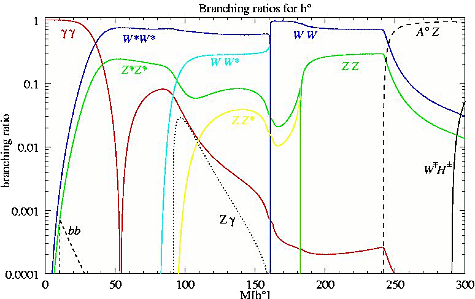
Fig. 1 - Branching ratios of h0 at mA0=150 GeV, mH+=210 GeV, mH0=300 GeV and delta= 0.1 in potential B.
Furthermore, there are four independent ways to couple the scalar fields to the fermions, known as models I to IV, amounting to a total of eight independent models. By contrast with the Minimal Super Symmetric Model, some of these models allow the existence of Higgs bosons with a suppressed or even zero coupling to the fermions- the so-called fermiophobic Higgs. We have studied [2] the decays of neutral fermiophobic Higgs in models A and B, in collaboration with an experimental group from DELPHI [3].
In fig.1 we show the branching ratios of the lightest Higgs particle in potential B with the other Higgs masses fixed. The parameter delta measures the degree of "fermiophobiness" of the lightest Higgs, with delta = 0 meaning no coupling to the fermions (see paper for details !!linkar!!).
In figs. 2 and 3 we show the experimental and theoretical bounds in the mh0-delta plane for potentials A and B. The experimental bounds were obtained from the limits of the searches for two photon final states at LEP [3, 4].
Our calculations were used by other experimental groups to search for fermiophobic Higgs bosons at LEP [4]. We will continue this collaboration with the experimentalists at the LHC within the ATLAS experiment.
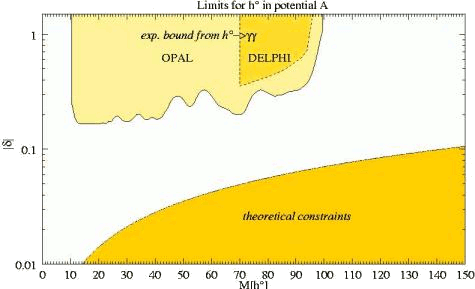
Fig. 2 - Bounds in the mh0-delta plane for potential A.
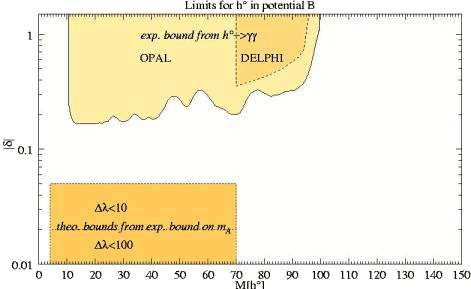
Fig. 3 - Bounds in the mh0-delta plane for potential B.
2 - Search for new quarks
Recent results from the DELPHI collaboration [5] led us to review the present bounds on the b' quark mass. We use all available experimental data for mb' > 96 GeV to constrain the b' quark mass as a function of the Cabibbo-Kobayashi-Maskawa elements in a sequential four generations model.
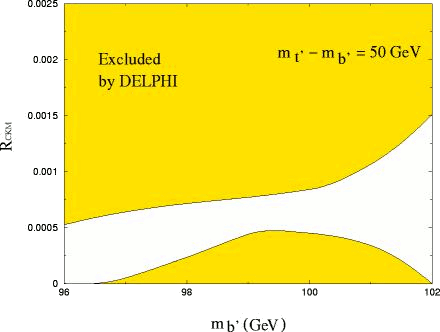
Fig. 4 - 95 % CL excluded region in the plane (RCKM, mb') with mt'-mb' = 50 GeV, obtained from limits on Br(b' → b Z) (bottom) and Br(b' → c W) (top) by the DELPHI coll.
There are several ways of extending the SM to accommodate a fourth family of quarks and/or leptons. A review of the different models in the literature is available in [6] . Obviously, the most natural and straightforward way to introduce a fourth family in the SM is to add a (t', b') family with the same quantum numbers and similar couplings to all other known quarks. The same can be done in the lepton sector. This is called a sequential fourth generation model and is sometimes referred to as SM4. The resulting CKM matrix has a very similar structure to the SM one. It is a 4×4 unitary matrix and it is assumed to be approximately symmetric. Besides the four new masses, there are 9 additional parameters with regard to the SM: 6 mixing angles instead of 3 and 3 complex phases instead of 1. Because we are not concerned with CP-violation we take all CKM values to be real.
In this model we define the quantity RCKM=(V(cb')V(tb'))/ V(tb), which measures the ratio of charged to neutral currents. Then, using all available experimental data from DELPHI, CDF and D0 [5, 8] for mb' > 96 GeV we shown that there is still plenty of room for a b' with a mass larger than 96 GeV. The allowed region shrinks as mt' increases. For some t' mass values the allowed region almost vanishes but because the tendency is towards a degenerate fourth family this region is probably large. All plots show that RCKM is smaller than approx 10-2 and it could be as small as approx 10-4. This is not surprising since this is what we expected it to be. In fact, the CKM values known so far suggest that V(cb') ≈ 10-4-10-3. If V(tb') ≈ 10-1 then a value of RCKM between 10-2 and 10-4 is absolutely natural. We plan to improve these results with new experimental data and to continue the study for the LHC. (Details in [9])
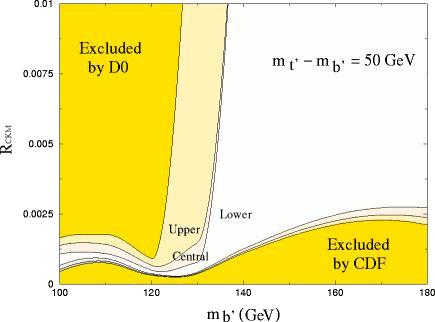
Fig. 5 - 95 % CL excluded region in the plane (RCKM, mb') with mt'-mb' = 50 GeV, obtained from limits on Br(b' → b Z) by the CDF coll. (bottom) and Br(b' → c W) by the D0 coll. (top). Upper, Central and Lower curves correspond to the values used for the b' production cross-section in hadron colliders.
References
-
- J. Velhinho, R. Santos and A. Barroso, "Tree Level Vacuum Stability In Two Higgs Doublet Models", Phys. Lett. B 322, 213 (1994).
-
- L. Brucher and R. Santos, "Experimental signatures of fermiophobic Higgs bosons", Eur. Phys. J. C 12, 87 (2000).
- A. Barroso, L. Brucher and R. Santos, "Is there a light fermiophobic Higgs?", Phys. Rev. D 60, 035005 (1999).
-
- P. Abreu et al. [DELPHI Collaboration], Phys. Lett. B 507, 89 (2001).
-
- G. Abbiendi et al. [OPAL Collaboration], Phys. Lett. B 544, 44 (2002).
-
- P. Achard et al. [L3 Collaboration], Phys. Lett. B 534, 28 (2002).
-
- P. H. Frampton, P. Q. Hung and M. Sher, "Quarks and leptons beyond the third generation", Phys. Rept. 330, 263 (2000).
-
- A. Arhrib and W. S. Hou, "Window on Higgs boson: Fourth generation b' decays revisited", Phys. Rev. D 64, 073016 (2001).
-
- T. Affolder et al. [CDF Collaboration], "Search for a fourth-generation quark more massive than the Z0 boson in p anti-p collisions at s**(1/2) = 1.8-TeV", Phys. Rev. Lett. 84, 835 (2000).
- S. Abachi et al. [D0 Collaboration], "Top quark search with the D0 1992 - 1993 data sample", Phys. Rev. D 52, 4877 (1995).
- C. D. Froggatt, D. J. Smith and H. B. Nielsen, "Could there be a fourth generation of quarks without more leptons?," Z. Phys. C 73, 333 (1997).
-
- S.M. Oliveira, R. Santos "Bounds on the mass of the B' quark, revisited", Jul 2003. 9pp. e-Print Archive: hep-ph/0307318
